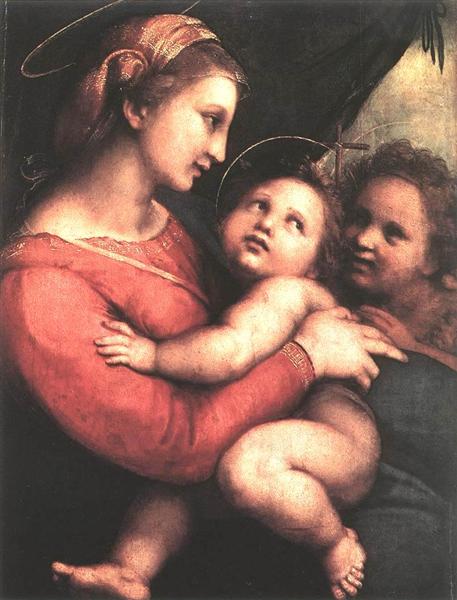Beskrivelse
Maleriet "Virgen de la Tenda", også kendt som "Madonna Della Tenda", skabt af Rafael i 1512, er et værk, der indkapsler mestringen af den italienske renæssance, som forfatteren bidrog og følelsesmæssig dybde. Dette særlige arbejde, der er placeret i Louvre Museum i Paris, præsenterer Jomfru Maria med barnet Jesus i et intimt og hyggeligt miljø, der inviterer seeren til at opleve en personlig forbindelse med guddommelighed og moderskab.
Brugen af stoffet, der giver sit navn til værket, bliver et centralt element, der giver en følelse af beskyttelse og varme. Strukturen af baggrunden er præget af et gardin, der skaber en intim og lukket atmosfære, hvor Mary -figuren præsenteres i forgrunden, oplyst på en subtil måde, der fremhæver hendes rolige tilstedeværelse. Denne brug af stoffet er symbolsk for, hvordan Rafael kunne bruge arkitektoniske og kostumeelementer til ikke kun at definere et rum, men også den følelsesmæssige kvalitet af scenen.
Hvad angår kompositionen, er Rafaels tilgang helt klart lodret med Mary som en central figur, der er på linje med den diagonale skabt af hans udvidede arm til barnet. Vinklen på hans hoved og hans bløde blik skaber en visuel forbindelse, der inviterer seeren til at følge sit blik til barnet, der spiller med et æble, symbol på fristelse og forløsning. Dette forhold mellem mor og søn udspringer en dyb lyrik, der er karakteristisk for Rafaels arbejde, hvor ansigtsudtryk og bevægelser er subtile, men ekstremt betydningsfulde.
Farven spiller også en afgørende rolle i arbejdet. Rafael bruger en varm farvet palet, overvejende den røde og guld, som ikke kun hjælper med at skabe en atmosfære af varme, men også giver liv til lysudtryk for karaktererne, især Marias, der skinner i hendes mantel. Den pulserende blanding af farver har ikke kun en æstetisk funktion, men skaber også en følelse af guddommelighed, der omgiver Jomfru og barnet.
De karakterer, der bor i dette arbejde, er symbolsk, da de ikke kun repræsenterer religiøse figurer, men også renæssance -idealer om skønhed og menneskehed. Marias position, i kombination med hendes skærm og moderlige udtryk og børns nysgerrighed, der afspejles i barnet Jesus, inviterer til refleksion over arten af moderens forhold i både guddommelige og menneskelige termer.
Et interessant aspekt af "Virgen de la Tenda" er, hvordan han forventer en vis udvikling af barokkunst, på trods af at han er et værk af renæssancen. Den dynamiske disposition, følelsesmæssige udtryk og en visuel fortælling, der fremkalder bevægelse, er et tegn på de stilarter, der ville komme senere. Brugen af lys og skygge er også sofistikeret, hvilket etablerer broer mod den fremtidige udvikling af kunstnere som Caravaggio.
Rafael efterlod personligt et uudsletteligt aftryk i vestlig kunst og hans evne til at flette spiritualitet og menneskehed i sine repræsentationer er det, der gør "Virgen de la Tenda" til et vedvarende vidnesbyrd om hans geni. Gennem dette arbejde bliver vi mindet om, at der kan fanges sacralitet i hverdagen, og at kunsten i sin reneste essens er beregnet til at kommunikere det ineffektive.
Gennem "Virgen de la Tenda" fejrede Rafael ikke kun moderfiguren i sin reneste og mest guddommelige dimension, men gav os også et vindue til hans indre verden, kendetegnet ved en dialog mellem det menneskelige og det guddommelige, der stadig resonerer i vores tider . Arbejdet er derfor ikke kun en teknisk succes, men et visuelt digt, der inviterer kontinuerlig meditation om skønhed, moderskab og åndelig tradition, der har udholdt gennem århundreder.
KUADROS ©, en berømt maling på din væg.
Håndlavede olie -malerier med kvaliteten af professionelle kunstnere og den karakteristiske segl af KUADROS ©.
Billeder Reproduktionstjeneste med tilfredshedsgaranti. Hvis du ikke er helt tilfreds med kopien af dit maleri, refunderer vi dine penge 100%.

